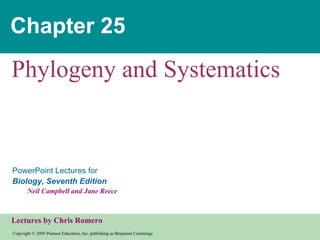Denunciar
Compartilhar

Recomendados
Classification of animals: Protozoa, Porifera and Coelenterata

Classification of animals: Protozoa, Porifera and CoelenterataDr. Sudesh D. Rathod, B N Bandodkar College of Science
Mais conteúdo relacionado
Mais procurados
Classification of animals: Protozoa, Porifera and Coelenterata

Classification of animals: Protozoa, Porifera and CoelenterataDr. Sudesh D. Rathod, B N Bandodkar College of Science
Mais procurados (20)
Iczn(The International Commission on Zoological Nomenclature )

Iczn(The International Commission on Zoological Nomenclature )
Introduction to zoological nomenclature and the ICZN

Introduction to zoological nomenclature and the ICZN
Classification of animals: Protozoa, Porifera and Coelenterata

Classification of animals: Protozoa, Porifera and Coelenterata
Semelhante a Chapter25
Semelhante a Chapter25 (20)
Ap Chapter 26 Evolutionary History Of Biological Diversity

Ap Chapter 26 Evolutionary History Of Biological Diversity
Último
Último (20)
New from BookNet Canada for 2024: BNC CataList - Tech Forum 2024

New from BookNet Canada for 2024: BNC CataList - Tech Forum 2024
Hyperautomation and AI/ML: A Strategy for Digital Transformation Success.pdf

Hyperautomation and AI/ML: A Strategy for Digital Transformation Success.pdf
Unleash Your Potential - Namagunga Girls Coding Club

Unleash Your Potential - Namagunga Girls Coding Club
DevoxxFR 2024 Reproducible Builds with Apache Maven

DevoxxFR 2024 Reproducible Builds with Apache Maven
Dev Dives: Streamline document processing with UiPath Studio Web

Dev Dives: Streamline document processing with UiPath Studio Web
Take control of your SAP testing with UiPath Test Suite

Take control of your SAP testing with UiPath Test Suite
WordPress Websites for Engineers: Elevate Your Brand

WordPress Websites for Engineers: Elevate Your Brand
Designing IA for AI - Information Architecture Conference 2024

Designing IA for AI - Information Architecture Conference 2024
DSPy a system for AI to Write Prompts and Do Fine Tuning

DSPy a system for AI to Write Prompts and Do Fine Tuning
Tampa BSides - Chef's Tour of Microsoft Security Adoption Framework (SAF)

Tampa BSides - Chef's Tour of Microsoft Security Adoption Framework (SAF)
Ensuring Technical Readiness For Copilot in Microsoft 365

Ensuring Technical Readiness For Copilot in Microsoft 365
"Subclassing and Composition – A Pythonic Tour of Trade-Offs", Hynek Schlawack

"Subclassing and Composition – A Pythonic Tour of Trade-Offs", Hynek Schlawack
H2O.ai CEO/Founder: Sri Ambati Keynote at Wells Fargo Day

H2O.ai CEO/Founder: Sri Ambati Keynote at Wells Fargo Day
Leverage Zilliz Serverless - Up to 50X Saving for Your Vector Storage Cost

Leverage Zilliz Serverless - Up to 50X Saving for Your Vector Storage Cost
Transcript: New from BookNet Canada for 2024: BNC CataList - Tech Forum 2024

Transcript: New from BookNet Canada for 2024: BNC CataList - Tech Forum 2024
Chapter25
- 1. Chapter 25 Phylogeny and Systematics
- 41. 4 Continuing the comparison of bases at sites 2, 3, and 4 reveals that each of these possible trees requires a total of four base-change events (marked again by crossbars). Thus, the first four sites in this DNA sequence do not help us identify the most parsimonious tree. 5 After analyzing sites 5 and 6, we find that the first tree requires fewer evolutionary events than the other two trees (two base changes versus four). Note that in these diagrams, we assume that the common ancestor had GG at sites 5 and 6. But even if we started with an AA ancestor, the first tree still would require only two changes, while four changes would be required to make the other hypotheses work. Keep in mind that parsimony only considers the total number of events, not the particular nature of the events (how likely the particular base changes are to occur). 6 At site 7, the three trees also differ in the number of evolutionary events required to explain the DNA data. RESULTS To identify the most parsimonious tree, we total all the base-change events noted in steps 3–6 (don’t forget to include the changes for site 1, on the facing page). We conclude that the first tree is the most parsimonious of these three possible phylogenies. (But now we must complete our search by investigating the 12 other possible trees.) Two base changes Figure 25.15b I II III IV I III II IV I IV II III I II III IV I III II IV I IV II III I II III IV I III II IV I IV II III I II III IV I III II IV I IV II III GG GG AA AA GG AA GG GG AA GG AA GG GG GG GG AA GG AA GG GG GG T G T G T T T T T G G T G T T G G T T T T 10 events 9 events 8 events
